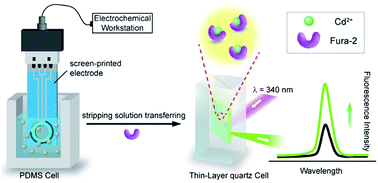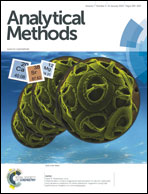A hybrid method combining an electrochemical technique and fluorescence measurement for the highly selective and sensitive detection of Cd2+†
Abstract
We developed a hybrid method combining an electrochemical technique and fluorescence measurement to detect Cd2+ in water samples. The electrochemical deposition and stripping technique provided a clean and selective pretreatment for transferring and concentrating Cd2+ from original turbid samples to blank buffer, followed by fluorescence quantification. Cd2+ in the original samples was co-deposited with Bi3+, which could provide a fresh bismuth film and concentrate a higher amount of Cd2+ onto a portable screen-printed electrode. The water-soluble compound Fura-2 was introduced as the fluorescent indicator for Cd2+ quantification, with the purpose of eliminating the error caused by the transfer to buffer. The detection results using real samples exhibited an excellent anti-interference ability, and showed a good linear correlation (correlation coefficient of R = 0.993). Moreover, the system was highly sensitive as a detection limit of 1.0 nmol L−1 could be achieved through a repeated electrochemical pretreatment process. This hybrid method is selective, sensitive, convenient and portable. It is promising for in field heavy metal ion determination in remote environments.


 Please wait while we load your content...
Please wait while we load your content...